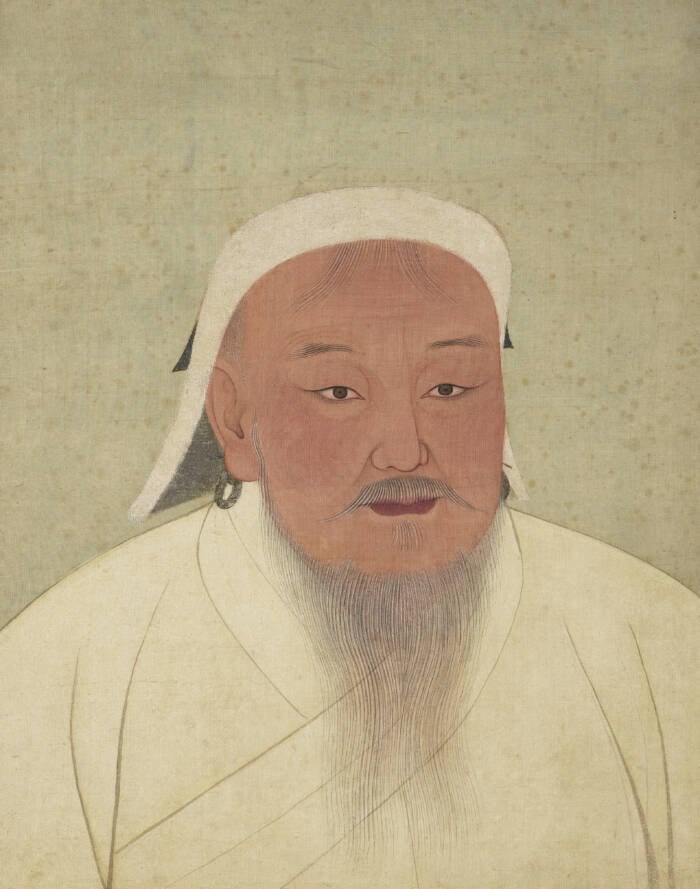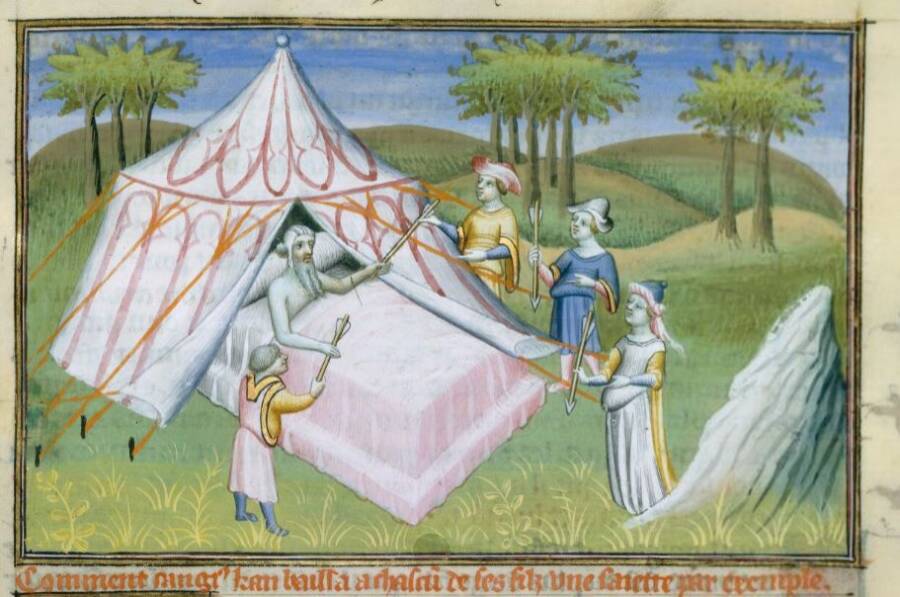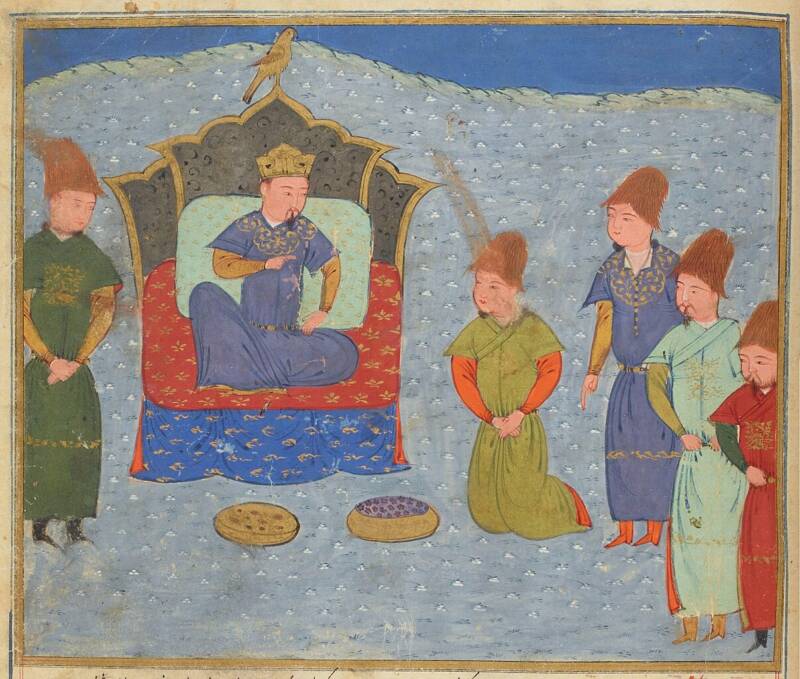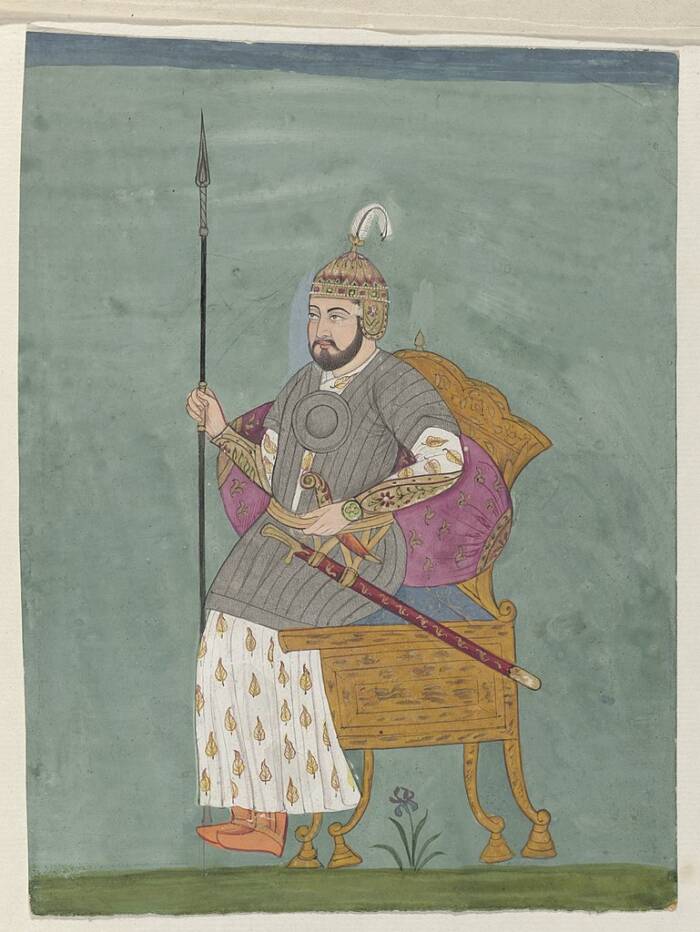The infamous conqueror is believed to have impregnated hundreds of women in his lifetime — and researchers believe as many as 16 million people may be descended from Genghis Khan today.

Wikimedia CommonsAbout one in 200 men is said to be descended from Genghis Khan.
There may be no conqueror in human history than successful than Genghis Khan. Once a humble and impoverished leader of a band of steppe nomads, for 20 years the Great Khan dismantled and subdued whole kingdoms with ruthless efficiency, spreading his rule from the Yellow Sea to the fringes of Europe.
Known for his military prowess and political genius, Genghis Khan was such a prolific ruler that he is rumored to have impregnated hundreds of women in his lifetime. In fact, in 2003, a scientific study revealed that not only is Genghis Khan’s bloodline alive and well today, it’s thriving — with one in 200 men, or about 16 million people, likely direct descendants.
This is the fascinating story of how one man gave rise to an empire and left behind an army of offspring.
Genghis Khan’s Humble Beginnings

Brooklyn Museum/Wikimedia CommonsWhile facing harrowing struggles as a young man, Genghis Khan found time to sire several children with his first wife, Börte.
Originally named Temüjin, the boy who would become Genghis Khan was born sometime in the early 1160s C.E. His father, Yesugei, was a chieftain of the Borjigin clan in what is now Mongolia, and his mother was Yesugei’s principal wife, Hö’elün.
Yesugei ruled the Khamag Mongol, a confederation of steppe tribes based in a fertile region of the Mongolian Plateau. A successful military commander, he named his son after a Tatar leader he’d captured shortly before Hö’elün gave birth.
When Temüjin was just nine years old, his father took him to a neighboring tribe to arrange his marriage to Börte, the daughter of a chieftain. Leaving his son behind, Yesugei began the journey back home.
On the way, he met a group of Tatars, who invited him to share a meal with them — and then poisoned the food in revenge for his recent attacks on the Tatars.
Upon his father’s death, Temüjin returned home to fill his father’s role as chief. However, the Borjigin clan abandoned the widowed Hö’elün and her children, leaving them struggling to survive as hunter-gatherers.
The Origins Of The Genghisid Dynasty
The Mongols believed a boy became a man at 15 years old. So, after Temüjin reached that age, he returned to Börte and married her.
Over the next few years, they would have four sons — Jochi, Chagatai, Ögedei, and Tolui — and several daughters.

Wikimedia CommonsGenghis Khan, top left, with his sons and grandsons.
Over time, Temüjin became involved in inter-tribal politics, establishing himself as a leading Mongol military ruler while consolidating support among his neighbors — either through alliance or conquest — on his quest to unify the people of the steppe.
Alongside his blood-brother, the Kereit khan Toghrul, Temüjin spent years battling rival confederations and tribes, including the Tatars who’d killed his father, and the Merkits, who had kidnapped Börte shortly after Temüjin married her.
As Erik Ringmar reported in History of International Relations, by 1206, Temüjin had amassed enough wealth and fame through military prowess to claim a new title: Genghis Khan, or “universal ruler.”
As he blazed across Asia, he would take at least five more wives and father many more children, founding bloodlines that exist to the present day.
Genghis Khan’s Genetic Legacy
In 2003, a study published in the American Journal of Human Genetics revealed that 0.5 percent of the world’s male population had nearly identical Y-chromosomes. Since the Y-chromosome typically remains unchanged as it’s passed from father to son, the study’s authors concluded that the only explanation could be a single male ancestor.
And because this ancestor was determined to have lived in Mongolia about 1,000 years ago, the researchers naturally theorized that this meant Genghis Khan.
With at least six wives, a reputed 500 concubines, and many other temporary partners, the fearsome Mongolian emperor is thought to have impregnated hundreds of women before his death in 1227.
His total offspring were never counted, but there were more than enough to found several dynasties — and for the Mongol Empire to have a serious succession problem just a few decades after his reign.
The Mongol Empire’s Succession Problem

Wikimedia CommonsGenghis Khan on his deathbed with his first four sons.
In Mongol custom, succession was a complex mixture of power and tradition loosely based on ultimogeniture, with the youngest son inheriting most of the father’s possessions.
However, this system often sparked intense sibling rivalries. And given how many children Genghis Khan seems to have fathered in his lifetime, this tradition was a recipe for disaster.
According to George Lane’s book Genghis Khan and Mongol Rule, on his deathbed in 1227, Genghis Khan told his sons, “With Heaven’s aid I have conquered for you a huge empire. But my life was too short to achieve the conquest of the world. That task is left for you.”
Power automatically passed to his youngest son, Tolui, until 1229, when a Mongol assembly appointed his third son, Ögedei, as Great Khan. The title then went to Genghis Khan’s grandsons, Güyük Khan and Möngke Khan.
When Möngke Khan died in 1259 without having declared an heir, a series of civil wars broke out. The empire splintered into four successor states: the Golden Horde of Eastern Europe, ruled by Jochi’s descendants; the Ilkhanate, in what is now Iran, under Tolui’s son Hulagu Khan; the Chagatai Khanate in Central Asia founded by Genghis’ second son Chagatai; and the Yuan dynasty, covering Mongolia, most of China, Korea, and parts of Russia.
The Many Heirs Of The Mongol Empire

Wikimedia CommonsBatu Khan, grandson of Genghis, was the first ruler of the Golden Horde, which endured for about 250 years.
Even after the fragmentation of the Mongol Empire, descent from Genghis Khan was a mark of prestige — and in some cases, a requirement to rule. Descendants of Genghis Khan left an indelible mark on history as generals, kings, and emperors.
Among them, Batu Khan, a grandson, commanded the Golden Horde and led the Mongol conquest of Eastern Europe. Kublai Khan became the first emperor of the Yuan dynasty and, at least in name, overlord of his grandfather’s entire territory, although his cousins would become more independent over time.

Rijksmuseum/Wikimedia CommonsTimur, or Tamerlane, had to employ two direct descendants of Genghis Khan to legitimize his rule.
Timur, who was allegedly indirectly descended from Genghis Khan, rose to prominence as a formidable conqueror and patron of the arts, founding the Timurid Empire in 1370. Timur’s great-great-great-grandson, Babur, who was also a direct descendant through his mother, founded the Mughal Empire, which endured for over 300 years on the Indian subcontinent until its destruction by the British Empire in 1857.
Besides these, the four successor states of the Mongol Empire further gave rise to dozens of kingdoms and states which rose or fell. In the 15th century, for example, Jochi’s descendants founded the Kazakh Khanate, which evolved into modern Kazakhstan.
Genghis Khan’s Modern Progeny

Wikimedia CommonsThe Onon River, near the Khentii Mountains of Mongolia, is said to have been Genghis Khan’s birthplace as well as the site of his tomb.
Today, some 16 million people can likely look to Genghis Khan as their direct ancestor. But the authors of the 2003 study argued that culture, not natural selection, is the reason for this. In short: Genghis Khan’s impressive lineage is the result of his vast empire, not biology.
“This is a clear example that culture plays a very big role in patterns of genetic variation and diversity in human populations,” geneticist Spencer Wells, one of the study’s authors, told National Geographic at the time. “It’s the first documented case when human culture has caused a single genetic lineage to increase to such an enormous extent in just a few hundred years.”
When Genghis Khan died under mysterious circumstances about 800 years ago, he allegedly ordered that his body be buried in a secret, unmarked grave near his birthplace in the Khentii Mountains. To this day, no one knows where his tomb is. Mongol legends hold that the site was trampled by horses, planted over with trees, or concealed by a river diverted over it.
However it was hidden, until some part of his remains can be found, none of his descendants can conclusively prove their lineage. And since many Mongolians believe Genghis Khan’s resting place should be left alone according to his wishes, we may never have definitive proof of his astonishing genetic output.
After learning about Genghis Khan’s impressive bloodline, meet these other descendants of famous figures. Then, discover the fascinating history of why the Great Wall of China was built.





